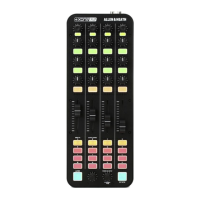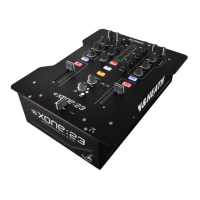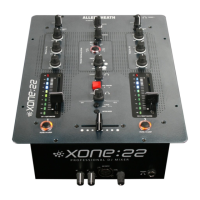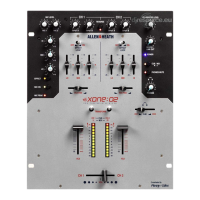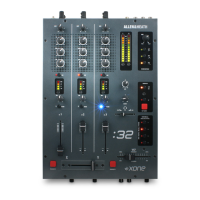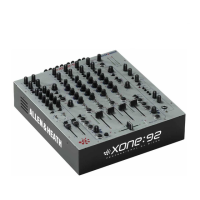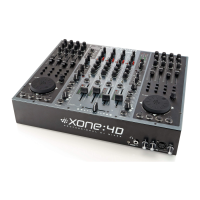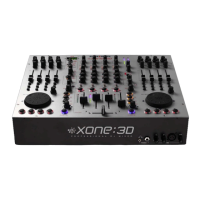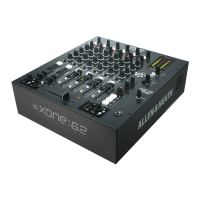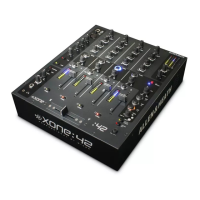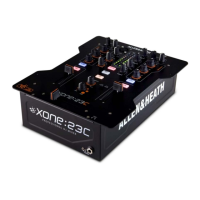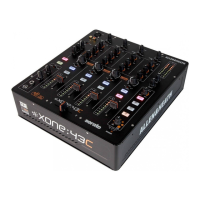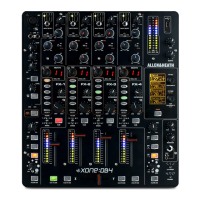
Do you have a question about the ALLEN & HEATH XONE:DB4 and is the answer not in the manual?
| Frequency range | 22 - 22000 Hz |
|---|---|
| Channels quantity | 4 channels |
| Digital sound processing | - bit |
| Number of EQ bands per channel | 4 |
| Line Signal-to-Noise Ratio (SNR) | 104 dB |
| XLR out | 2 |
| Microphone in | Yes |
| Line inputs (RCA) | 8 |
| Headphone connectivity | 3.5 mm/6.35 mm |
| USB 2.0 ports quantity | 1 |
| Product color | Black |
| Video capability | No |
| Depth | 358 mm |
|---|---|
| Width | 320 mm |
| Height | 88 mm |
| Weight | 5100 g |
| Package depth | 260 mm |
| Package width | 530 mm |
| Package height | 470 mm |
| Package weight | 8600 g |
Details the limited one-year warranty for product defects in materials or workmanship.
Outlines the conditions under which the warranty is valid, including proper installation and use.
Lists all items included in the XONE:DB4 package, ensuring all components are received.
Illustrates the layout of controls and connectors on the top panel of the XONE:DB4 mixer.
Shows the rear panel connections, including inputs, outputs, and power.
Provides a visual guide to connecting the XONE:DB4 in a typical DJ setup with various audio sources and outputs.
Introduces the XONE:DB4 mixer, highlighting its features, capabilities, and design philosophy.
Describes the balanced XLR input for microphones, specifying type and cable recommendations.
Explains how to select between microphone and stereo line input sources.
Details the dual RCA sockets for connecting external line-level audio sources.
Describes the function of the gain control for adjusting input signal level.
Explains the EQ adjustments for the microphone channel to shape tonal quality.
Indicates when the channel signal is close to clipping.
Allows listening to the channel pre-fade signal in headphones.
Sets the level of the channel signal in the main mix.
Turns the channel on or off, routing its signal to the main mix.
Selects channel output routing between the main mix or Channel I input.
Allows selection of input sources for the music channel from various available options.
Amplifies or attenuates the input signal level by up to ±10 dB.
Illuminates if the input signal is within 3dB of clipping.
Configurable EQ or High-Pass/Low-Pass filter for tonal adjustment.
Records and loops input audio source, showing length and beat detection.
Selects one of five basic effect types, illuminating to show the selected effect.
Moves focus to a channel or opens the FX library for effect selection.
Adjusts a parameter of the selected FX, like regeneration for delay.
Sets the balance between the original (DRY) and effected (WET) signal.
Routes the channel signal to Filter-1, Filter-2, or directly to the mix.
Routes the channel signal to Crossfade-X, Crossfade-Y, or directly to the mix.
Allows listening to the channel pre-fade signal in headphones.
Displays the channel signal level, post-EQ and pre-fader.
Adjusts the channel signal level from fully off to fully on.
Controls the 'Q' or resonance of the filter, affecting the sound's dramatic effect.
Activates the high pass filter slope, cutting bass frequencies.
Activates the band pass filter slope, shaping mid-range frequencies.
Activates the low pass filter slope, cutting treble frequencies.
Sets the cut-off frequency of the filter from very low to very high.
Switches the filter effect on and off, with latching and momentary modes.
Explains momentary selection of filter bands and filter on/off operation.
For USB memory stick insertion for settings and firmware updates.
Main meters displaying selected monitor source level, with SPLIT CUE functionality.
Adjusts the main mix XLR output level for the house sound system.
Adjusts the level for the stereo monitor RCA output, for booth or zone feeds.
Pans between cue signal and main mix output in headphones.
Adjusts the headphone signal level.
Connects stereo headphones via 1/4" TRS and 3.5mm mini-jack.
Sets the response curve for the channel faders to suit music style.
Sets the response curve for the crossfader, suitable for scratching.
Lists analogue input options for channels, including Line, Phono, and Microphone.
Details USB ASIO Soundcard outputs mapped to mixer channels.
Describes S/PDIF inputs available for digital audio sources.
Rotary switch to select input source for a channel.
Toggle switch for selecting between Analogue, USB, and Digital sources.
EQ mode with steep 24dB/octave slope for tight frequency isolation, indicated by blue lights.
EQ mode with gentler 12dB/octave slope, suitable for various music styles, indicated by red lights.
EQ section acts as HPF/LPF with resonance control, indicated by blue/red lights.
Adjusts high frequencies or acts as a low-pass filter in Filter mode.
Adjusts mid frequencies or filter resonance (Q).
Adjusts low frequencies or acts as a high-pass filter in Filter mode.
Selects the desired EQ mode, changing knob pointer illumination colour.
Adjusts loop length from 4 bars to 1/16th of a beat.
Activates or deactivates the looper with latching or momentary modes.
Shows the currently selected loop length and BPM activity.
Illuminates when the loop is active.
Describes the Delay effect and its parameters like time and regeneration.
Describes the Reverb effect and its parameters.
Describes the Resonator effect and its parameters.
Describes the Modulator effect and its parameters.
Describes the Damage effect and its parameters.
Sets the balance between the original (DRY) and effected (WET) signal.
Controls a further parameter of the selected FX, like regeneration.
Explains how to select, focus, and turn on effects.
Details how to browse and load alternative effect presets from the internal library.
Explains the layout of the FX display screen and its segments.
Describes how focus shifts between channels and parameters.
Adjusts secondary effect parameters and toggles display view.
Sets beat fraction for effects, allows BPM tapping, and BPM locking.
Describes how to mute send to effects for decay, with interlock feature.
Allows setting delay time in milliseconds or BPM fractions.
Guides selection of tempo range to improve BPM detection accuracy.
Resets the BPM detection system to re-analyze tempo.
Allows manual tapping of tempo to sync effects or extend loop length.
Locks the current tempo to prevent changes when switching sources.
Enables using MIDI clock as the timing source, overriding BPM detection.
Configures the display mode for VU meters (Peak, Bar, Dot).
Allows remote control of DJ CD player PLAY/CUE functions.
Resets all user settings to factory defaults.
Loads previously saved mixer settings from a USB key.
Stores current mixer settings to a USB key.
Instructions for loading new firmware to update the mixer's software.
Selects the tempo range for BPM detection and MIDI clock sync.
Adjusts the brightness of the front panel LEDs.
Configures routing options for upstream USB audio sends to the computer.
Sets headphone sensitivity, audio source, and cue modes like Split and Normal.
Configures trim level, source, and phase for record outputs.
Configures trim level, source, and phase for booth monitor outputs.
Configures trim level and phase for main mix outputs.
Step-by-step guide to download and install new firmware for the XONE:DB4.
Alerts users about potential issues during firmware updates and hard reset procedures.
Explains the naming convention for soundcard inputs and outputs.
Details the eight soundcard outputs and their mapping to USB channels.
Guides selection of USB audio sources for input channels.
Maps mixer sources (Mixer, Channel) to soundcard inputs (Sends).
Details USB audio sends from Analogue In, Digital In, and Channel PFL.
Details USB audio sends from Booth, Record, Mix, and Phones outputs.
Refers to "USB Routing" for selecting soundcard input sends.
Step-by-step guide for installing USB audio and MIDI drivers on Windows.
Instructions on when to connect the XONE:DB4 to the PC during driver installation.
Guides through Windows security prompts during driver installation.
Instructs to reboot the computer to complete the driver installation.
Important notes regarding USB port usage and system compatibility.
Verifies successful driver installation using Device Manager.
Locating and launching the XONE:DB4 driver package (.dmg file).
Guides through the installer steps: Introduction, Destination Select, Type, Installation, Summary.
Prompts for the user's system password to authorize installation.
Confirms the desire to continue the software installation process.
Instructs to restart the Mac to finalize the driver installation.
Verifies successful driver installation using Audio MIDI Setup and MIDI Studio.
Explains MIDI as an interface protocol for communication between musical devices.
Enables remote DAW control by disconnecting mixer functions and sending MIDI data.
Details MIDI messages for input selection and trim controls.
Details MIDI messages for EQ controls and mode selection.
Details MIDI messages for FX, filter, crossfader, and cue functions.
MIDI messages for channel faders and FX on/off switches.
MIDI messages for fader and crossfader curve selection.
MIDI messages for filter controls (Res, HPF, BPF, LPF, Freq, On).
MIDI messages for additional controls like HF, LF, Mix, Booth, FX ADJ.
MIDI messages for controls when MIDI Shift mode is active.
Describes the digital RCA inputs and fixed digital output specifications.
Explains the proprietary interface protocol for connecting accessories.
Lists technical specifications for analogue/digital conversion, DSP, and sampling frequencies.
Lists operating levels for main, monitor, and record outputs, plus mic sensitivity.
Provides physical dimensions and weights for desktop, rack-fitted, and packed configurations.
A blank section for user notes.
Instructions for registering the product online or by mail for warranty purposes.
